VP2770-LED Vs. S27B970D: 27" Monitors At 2560x1440
If you demand maximum pixel density and the highest resolution on your desktop PC, these 27-inch screens from ViewSonic and Samsung do not disappoint. Today, we put ViewSonic's VP2770-LED and Samsung's S27B970D to the test. Is QHD right for you?
Results: Grayscale Tracking
All of the IPS panels we’ve tested recently display excellent grayscale tracking, even at stock settings. It’s important that the color of white be consistently neutral at all light levels from darkest to brightest. Grayscale performance impacts color accuracy with regard to the secondary colors; cyan, magenta, and yellow. Since computer monitors typically have no color or tint adjustment, accurate grayscale is key.
ViewSonic VP2770-LED
To perform a manual calibration of the VP2770-LED, we employed the User color mode. The other modes lock out the RGB adjustments. Selecting the sRGB preset also prevents use of the Contrast and Brightness sliders. The pre-calibration chart below reflects the User mode with the RGB controls set to their default positions.

The color of white tends a bit towards blue as the signal level rises. The error becomes visible at 40 percent, and hits a max of just over six Delta E at 100 percent. This is a slightly cool tone and an average out-of-box result.
After calibrating the VP2770-LED, the grayscale tracking is quite excellent. Only small adjustments need to be made to bring everything in line.

Our final settings are Red 98, Green 100, and Blue 94, with contrast set to 70 and Brightness to 42. This is perfect tracking with an average Delta E error of only 0.8604. It doesn’t really get much better than this.
Samsung S27B970D
Stay on the Cutting Edge
Join the experts who read Tom's Hardware for the inside track on enthusiast PC tech news — and have for over 25 years. We'll send breaking news and in-depth reviews of CPUs, GPUs, AI, maker hardware and more straight to your inbox.
As mentioned earlier, the S27B970D offers several unique options with its color modes. The first chart is the factory-calibrated mode. As previously stated, the only way to adjust this is to use the Natural Color Expert software with a supported color probe. The chart below represents the monitor in its default state.
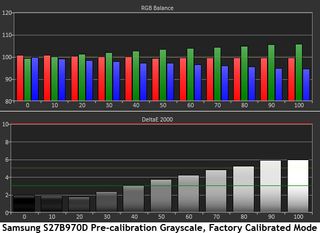
The result is somewhat green in hue, with the error increasing as the light level goes up. The error becomes visible at 50 percent and it hits a max Delta E of just under six. Given a choice, we’d rather see blue errors than green because the human eye is most sensitive to green, and therefore better able to detect that error.
This is the Standard mode measurement. The green error is still present, but slightly lower. Visibility doesn’t occur until 80 percent, and the max Delta E is now under four.
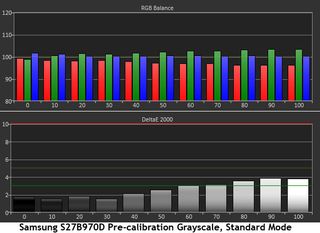
If you don’t plan to calibrate the S27B970D, we recommend Standard mode. The color is pretty accurate without adjustment, and you’ll be able to control brightness and contrast.
After a manual calibration, the results are just a hair short of perfect.
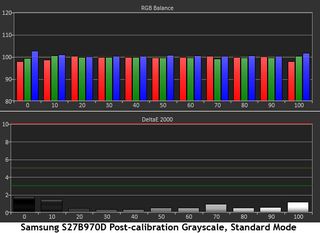
Calibrating the Standard mode produces one of the best charts we’ve ever seen. Only zero and 10 percent are over one Delta E, and that can even be attributed to instrument error. While the human eye cannot distinguish between the Samsung and ViewSonic monitors we're measuring, we remain very impressed by this level of accuracy.
All of the monitors we’ve tested recently show an extremely low grayscale error right out of the box. While we recommend calibration of any panel, you can still enjoy an accurate image from any of these screens at their stock settings.
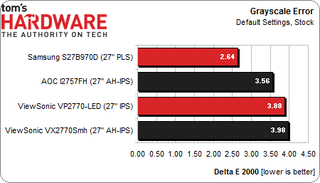
The Samsung S27B970D is the only panel to measure under three (average Delta E). This result is for the monitor’s Standard mode; the factory-calibrated mode measured higher, with an average Delta E of 3.76.
After calibration, both the Samsung and ViewSonic panels had essentially no grayscale error. This is near-perfect performance.
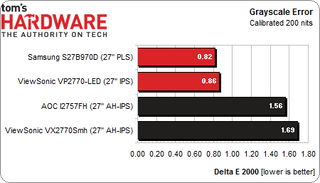
In most cases, calibration will yield a reasonable improvement over the stock image. With the monitors reviewed here, the improvement is more significant. It should be noted that Samsung’s Natural Color Expert software was not able to achieve a grayscale error this low. The best we could do was 2.14 Delta E average. The obvious conclusion is that a manual calibration is preferable for the S27B970D.
Current page: Results: Grayscale Tracking
Prev Page Results: Gamma And ANSI Contrast Ratio Next Page Results: Color Gamut And Performance
Christian Eberle is a Contributing Editor for Tom's Hardware US. He's a veteran reviewer of A/V equipment, specializing in monitors. Christian began his obsession with tech when he built his first PC in 1991, a 286 running DOS 3.0 at a blazing 12MHz. In 2006, he undertook training from the Imaging Science Foundation in video calibration and testing and thus started a passion for precise imaging that persists to this day. He is also a professional musician with a degree from the New England Conservatory as a classical bassoonist which he used to good effect as a performer with the West Point Army Band from 1987 to 2013. He enjoys watching movies and listening to high-end audio in his custom-built home theater and can be seen riding trails near his home on a race-ready ICE VTX recumbent trike. Christian enjoys the endless summer in Florida where he lives with his wife and Chihuahua and plays with orchestras around the state.
-
mayankleoboy1 ReplyWhy wouldn't you want a QHD screen like one of these two?
Everything gets smaller.
So increase the DPI scaling ?
-
MauveCloud BigMack70I'm glad to see 1440p monitors getting some attention, but I just don't see the prices of these being justifiable to most users over the USA-based Korean 1440p IPS panels that are starting to become more numerous.$800-1200 is just nuts for anyone using these for home use or gaming, IMO.Reply
Agreed. I bought a Dell U2711 a few months ago, but if something forced me to replace it, I'd probably go with one of those cheap Korean panels -- or a TN panel 2560x1440 monitor if somebody would actually make one - I doubt I'm the only one who likes the resolution but isn't so picky about color quality. I had no objection to the color quality on my Samsung P2770HD, and the color shifts of a TN panel are affected by the physical size of the monitor, not the resolution, right? -
Why not do a review on those $330 Korean 1440P monitors that enthusiasts talk about? I like to see what i am missing with the extra $900. Really i'm serious i really want to know what justifies the 1 grand price tag.Reply
-
cangelini jupiter optimus maximusWhy not do a review on those $330 Korean 1440P monitors that enthusiasts talk about? I like to see what i am missing with the extra $900. Really i'm serious i really want to know what justifies the 1 grand price tag.It's coming. We're ramping up our display coverage, so we took note of the requests after the last display piece and put in the requests. You'll see this soon. Of course, if there are any other requests from you guys, do let us know. Christian is doing a phenomenal job of applying his extensive experience on Tom's Hardware.Reply -
EzioAs Dell's UltraSharp U2713HM is less than $600 in my country if we go by standard conversion. Would you guys say that's a good price?Reply -
festerovic cangeliniIt's coming. We're ramping up our display coverage, so we took note of the requests after the last display piece and put in the requests. You'll see this soon. Of course, if there are any other requests from you guys, do let us know. Christian is doing a phenomenal job of applying his extensive experience on Tom's Hardware.That's great to hear, I agree with the others that the price of these models is too much to consider unless they were generating $$$s for me. $3-400 seems like the range I would be willing to spend on these. And as for the USA based korean cheap models, are there any legit retailers of these? Please point me at them.Reply -
JOSHSKORN Just bought a ASUS VS278Q-P for $310. It's a 60Mz monitor and I do game, but I'm happy. My previous monitor lasted 8 years (Samsung SyncMaster 213T, bought it for $1k). I'll upgrade when this one dies, hopefully 4k/UHD will be affordable. Supposedly, only serious gamers can tell the difference between 60Hz and 120Hz. I'm not a serious gamer, so it works just fine for me. 120Hz monitors of that size are nearly twice the price.Reply -
mannam Reply10449443 said:It's coming. We're ramping up our display coverage, so we took note of the requests after the last display piece and put in the requests. You'll see this soon. Of course, if there are any other requests from you guys, do let us know. Christian is doing a phenomenal job of applying his extensive experience on Tom's Hardware.
Here are the inexpensive $300-$400 27" korean monitor brands: Yamakasi Catleap, Achieva Shimian, Crossover, PCBank, Potalion, Auria
"The reason these monitors are cheap - LG makes IPS panels for apple cinema displays. Apple only accepts grade A+ panels. That means the all the grade A,A-,B+, etc are not accepted and returned to LG. LG resells those IPS panels to other manufacturers. You can get the whole story on google if you're interested. In addition, you're getting no support and no manufacturers warranty."
Source: http://www.mmorpg.com/gamelist.cfm?game=239&view=forums&post=5192222#5192222
It would be really interesting to get a review of these monitors that go for 50% or less of the price of the Big Brand stuff. If it's even 85-90% quality compared to the big brands, then they are worth the plunge. :D -
ubercake Personally, I was not impressed with the Auria monitor. My Acer HN274H TN monitor has better contrast. Viewing angles are far better on the Auria, but that's to be expected on an IPS. At any rate, I returned the Auria after a day of use because after many attempts to adjust the contrast/color, it didn't hold a candle to the colors or contrast on my TN. The Auria definitely had deeper black, but the in-betweens seemed to be missing no matter how I set the contrast and color. I honestly couldn't justify the tradeoff of higher resolution to lack of contrast. Maybe I got one of the LG B+ throw-away panels?Reply
Most Popular

